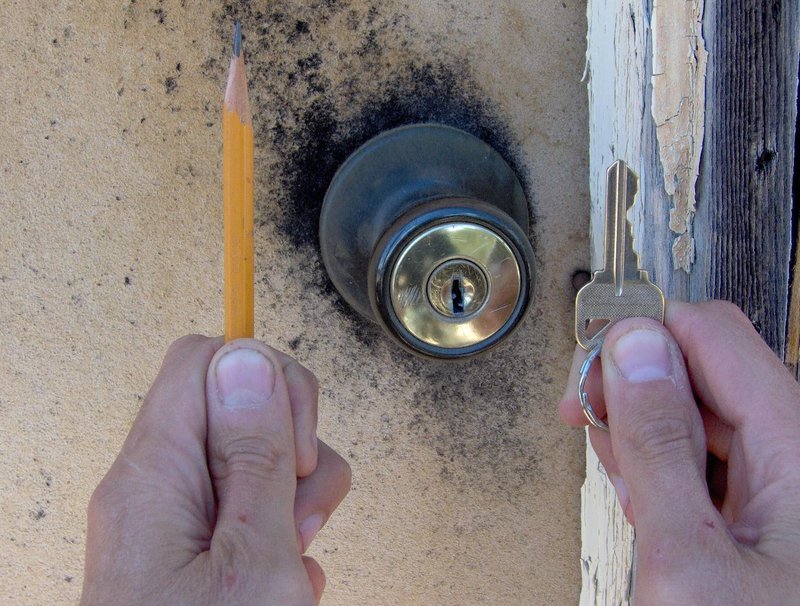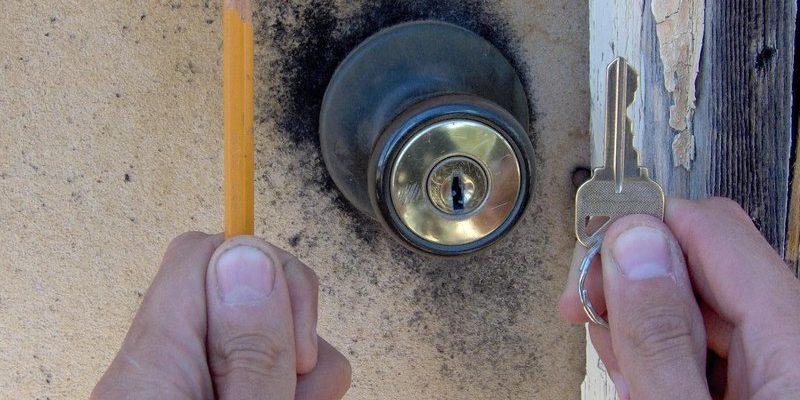
Let me explain. Most standard exterior door locks—whether you have a Schlage, Kwikset, or Yale—use a pin-and-tumbler design. When those tiny parts inside get dry, dirty, or just plain stubborn, your key gets stuck or feels gritty when you turn it. Instead of reaching for an oily spray or risking the wrong lubricant, you can use graphite from a pencil for a quick, clean fix.
Why Use a Lead Pencil Instead of Spray Lubricant?
Spray lubricants like WD-40 or silicone sprays seem handy, but they’re not always the best option for locks—especially the ones exposed to weather outside. Here’s why. Most of these products are oil-based, and while they help at first, they tend to attract dust, grit, and dirt over time. That mess can actually make your lock stickier in the long run. Plus, oily residue can gum up the internal pins and springs that let your lock work smoothly.
A lead pencil—more accurately, a graphite pencil—uses a dry lubricant. *Graphite* naturally reduces friction, letting all those tiny components inside your lock slide past each other instead of grinding or sticking. The best part? Pencil graphite doesn’t attract nearly as much dirt. It’s cheap, easy to use, and won’t leave a greasy mess on your hands or key.
Honestly, before you try anything else, grabbing a regular No. 2 pencil is one of the safest and quickest fixes for most sticky locks.
How Graphite Lubricates Your Door Lock
You might be wondering, “How does rubbing a pencil on my key actually help?” Here’s what’s happening. The “lead” in pencils is actually graphite—a super-slippery form of carbon. When you layer graphite onto your key, it transfers directly onto the inside of the lock as you push the key in and turn it. Those microscopic graphite particles work their way around the lock’s pins and tumblers, helping everything move more smoothly.
Graphite isn’t sticky at all; it’s basically a dry powder. That’s why locksmiths often recommend dry lubricants for locks—especially exterior ones, where rain, snow, and dust can quickly turn oil-based lubes into a gritty mess. Graphite simply sits on the surface, providing just enough slip for the pins and springs to move, but not enough for grime to build up.
Let me paint a picture: imagine putting a thin layer of powder on a squeaky door hinge instead of oil. The door still moves smoothly, but dust and dirt don’t stick around. That’s the same idea here, but for your lock.
What Type of Pencil Works Best for Lubricating Locks?
If you’re standing in front of your lock with a mechanical pencil or a colored pencil, here’s what you need to know. The best pencil for lubricating a sticky exterior door lock is a classic wood-cased No. 2 pencil. The “No. 2” refers to the hardness rating, and it’s what you probably used for bubble tests in school. This grade is soft enough to leave a good layer of graphite, but not so soft that it breaks off in big chunks.
Avoid mechanical pencils for this job—they tend to be harder and don’t leave enough graphite behind. Colored pencils and art pencils sometimes contain wax or clay, which can actually make things worse by gumming up your lock. Stick with standard graphite pencils for the best results.
If you have a specialty *graphite lubricant* in a tiny tube (sometimes sold at hardware stores), that works too—but for most people, a regular No. 2 pencil is easy, cheap, and sitting right in your junk drawer.
Step-by-Step: How To Lubricate a Sticky Lock With a Lead Pencil
Let’s break it down. Here’s how you use a lead pencil to lubricate your sticky exterior door lock, step by step:
- Grab a No. 2 pencil. Make sure it’s sharpened, because you’ll need a good point.
- Coat your key with graphite. Take the key you usually use for the door and rub the pencil lead all over the grooves, teeth, and flat sides. Apply firm pressure—don’t be shy. The darker your key looks, the better.
- Insert and remove the key several times. Stick the coated key into the lock and slide it in and out 5–10 times. Each time, you’re depositing more graphite inside the lock’s pins and tumblers.
- Turn the key to work the graphite in. Turn the key left and right (lock and unlock positions, if possible) a few times. You might feel the motion get smoother already.
- Repeat if needed. Still feels sticky? Re-coat the key and repeat the process once or twice more.
- Wipe the key clean. If any extra graphite is left on your key, just wipe it off with a tissue or cloth—no need to leave a mess in your pocket or purse.
You’ll probably notice improvement right away, but sometimes it takes a few insertions to fully distribute the graphite inside.
When to Replace Instead of Lubricate Your Door Lock
Here’s a reality check: lubricating with a lead pencil works for most minor sticking or grinding issues, but it’s not a magic fix for everything. If your key is still hard to turn, won’t go in all the way, or the lock feels loose and wobbly, you might have a different problem. Sometimes internal pins wear out, springs break, or something metal inside bends or snaps. In those cases, graphite can’t help.
If your lock is completely seized, your key snaps, or you notice rust or water dripping out, it’s time to call a locksmith or think about replacing the hardware. Brands like Schlage, Kwikset, and Yale make replacement lock cylinders you can swap out yourself if you’re handy. If not, a professional can do it for you.
Honestly, if your lock is old and sticky every month—even after graphite or other troubleshooting—it’s probably worth the peace of mind to just upgrade it.
Other Safe Ways to Lubricate Exterior Door Locks
Maybe you’re fresh out of pencils, or you’re curious about other options. There are a few other ways to lubricate a sticky exterior door lock safely:
- Commercial graphite powder: Sold in little squeeze tubes at most hardware stores, this is pure graphite—no pencil required. Just puff some right into the keyhole and work the key around.
- Teflon-based dry sprays: Sometimes called “PTFE sprays,” these are safe for locks because they don’t leave sticky residues or trap dust. Brands like Tri-Flow and DuPont make good ones.
- DO NOT use oil-based sprays (like WD-40) regularly: These might help in a pinch, but they build up grime over time and can cause more trouble down the road.
If you’re ever unsure, stick with graphite or Teflon-based options. Don’t take chances with expensive or weather-exposed locks.
How To Prevent Exterior Door Locks From Getting Sticky
Prevention is always easier than wrestling a stuck lock in the dark. Here’s how you can keep your locks working smoothly:
- Lubricate regularly: Once every 6–12 months, apply graphite with a pencil or a squeeze tube.
- Keep the lock covered: If your lock sticks out and gets hit by rain or snow, consider adding a simple cover or shield to deflect water and dirt.
- Use the right key: Worn-out or bent keys can make locks feel sticky. If you notice your key is getting tough to turn, try using a spare or make a new one.
- Check for alignment: If your door or frame sags, it can throw the lock’s inner workings out of sync. Make sure the latch and strike plate line up so the lock doesn’t have to work overtime.
Regular care means less troubleshooting down the line—no emergency pencil hunts at midnight.
Why Your Exterior Door Lock Gets Sticky in the First Place
You might be curious what causes locks to stick, especially the ones on outside doors. Here’s the short version: exposure. Weather, temperature swings, and gunk all play a part. When rain, dust, pollen, or even tiny bugs get inside the keyhole, they stick to the metal parts and make it harder for everything to move. Cold weather can make metal shrink and bind. Heat can dry out old lubricants and leave things gritty.
Sometimes it’s just age—normal wear means those tiny pins and springs inside don’t glide as easily as they once did. Using the wrong key, or forcing one that isn’t a perfect match, can also scar the inside of the lock and leave it even trickier to turn.
Lubricating with a lead pencil is such a handy fix because it addresses the most common cause: dry, dusty, or dirty pins and tumblers needing a little extra slip without inviting more dirt in.
Wrapping Up: A Simple Fix for a Sticky Problem
If your exterior door lock is giving you grief, don’t panic—or reach for whatever mystery can is under the sink. Sometimes, the simplest solution works best. Using a lead pencil gives you a clean, dry, and safe way to lubricate a sticky lock without making a bigger mess or calling in backup. Next time your key gets stuck, try the pencil trick before anything else. It’s fast, it’s easy, and honestly, it’s a little bit satisfying to fix a sticky problem with such an everyday tool. Give it a try—and enjoy those smooth, drama-free door unlocks.
